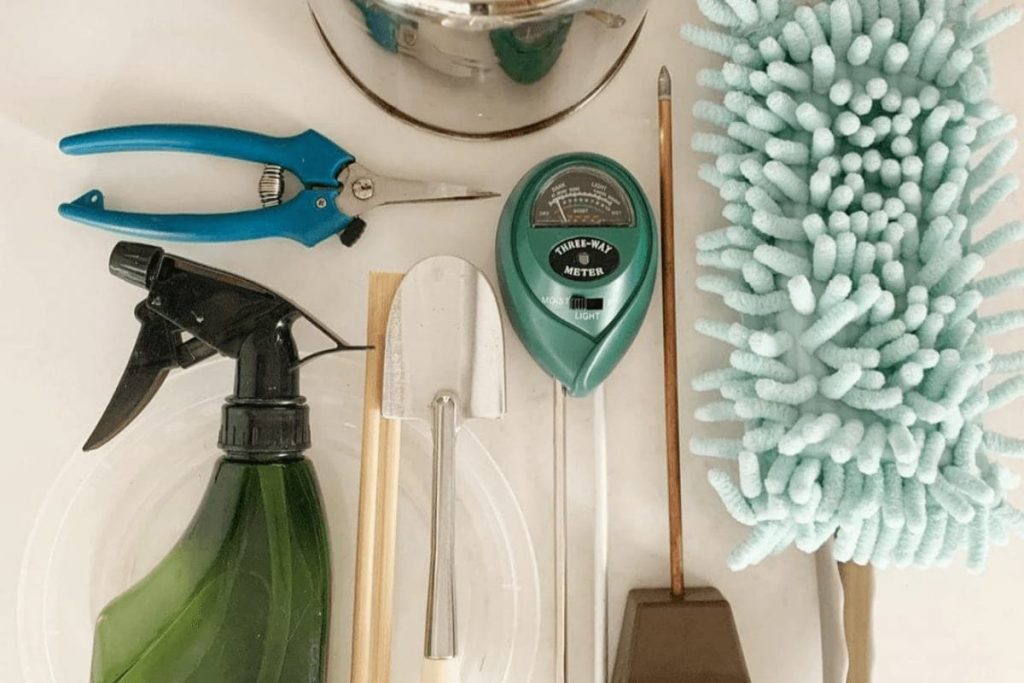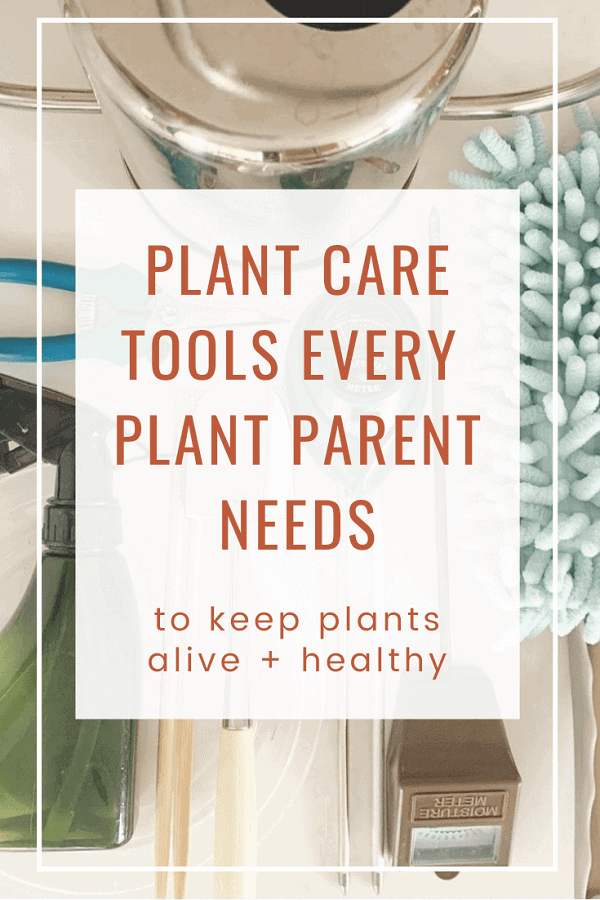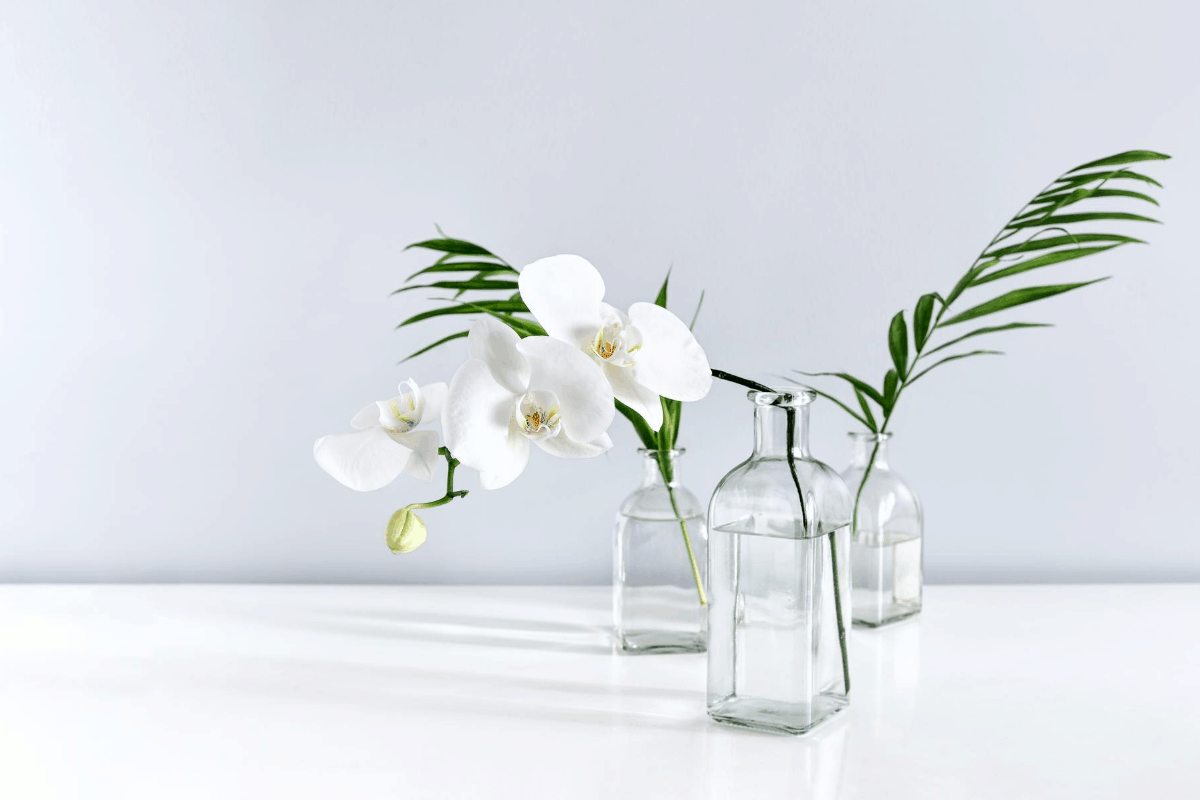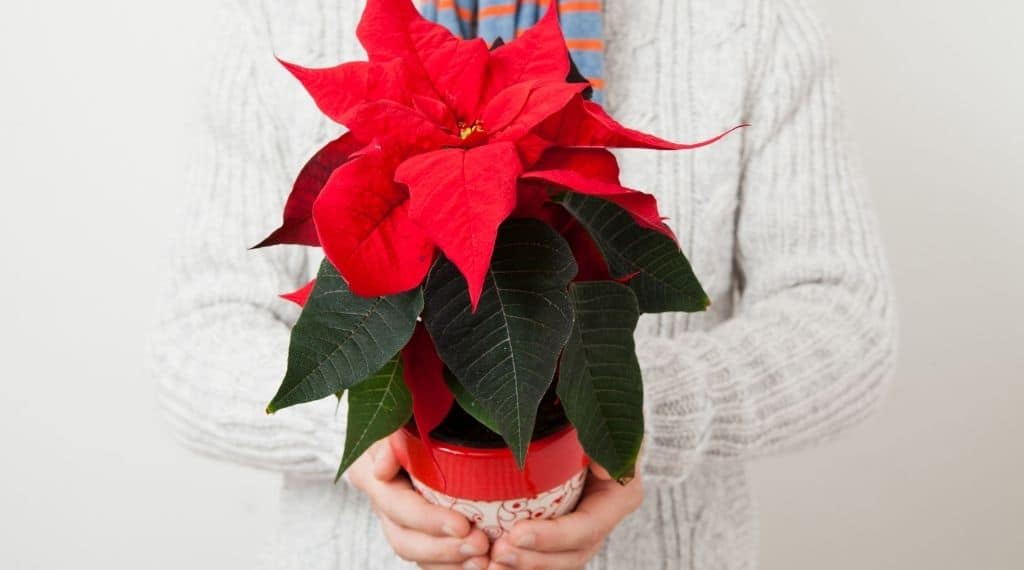Last Updated on October 13, 2021 by Plantiful Interiors
Indoor Plant Care Tools
Featured Image Courtesy of: Instagram @lifesoulgarden
We’ve all seen the Instagram feeds of people’s houses decorated with stunning greenery and pretty flowers from top to bottom, with not a brown leaf in sight.
But seemingly everything that enters your home dies within a week. You’ve even managed to kill the unkillable: a cactus.
So, how do these Instagrammers always manage to keep their home looking like something out of a Good Housekeeping magazine?
Its not magic, nor do you need a degree in Horticulture (phew).
With just a few simple indoor plant care tools and a little bit of guidance, you too can learn the basics of how to care for any indoor plant, without having to watch endless YouTube tutorials or clearing out your local garden center.
Never will a plant die on your watch again!
This post contains affiliate links. As an affiliate partner of various brands, we earn a little commission on qualifying purchases, at no extra cost to you. When you purchase through our links, you help our business to keep going. So thank you for your support! You may read our full disclaimer for more information.
We’ve compiled this comprehensive beginners guide to indoor plant care tools that will also teach you how to care for your new house plants.
You’ll also find ideas on which plants are best for beginners, where to place your new plants in your home. In addition to the must have indoor plant care tools to keep your house plants alive and healthy.
Let’s dive in!
The Best Indoor Plant Care Tools Every New Plant Parent Must Have
Like with any job at hand, preparation is key. You wouldn’t start making a cake without the necessary ingredients, and caring for your plant is no different.
Don’t worry though; this doesn’t mean having to fill up your cart at your local gardening store with expensive gadgets and knickknacks.
Just the minimal essential tools will make your life easier and set you up for success with your new found hobby.
Here are some basic gardening tools you should always have at the ready to properly care for your indoor plants:
Indoor Plant Care Tools: Pruners
OUR TOP PICK
The quintessential gardener’s tool! A good pair of pruning shears will help you trim back any unruly stems and dead-head any flowers that are past their prime.
Choosing the best pruners for indoor plants can be a little overwhelming, as there are so many types available to buy.
We suggest you start with a pair of these bypass pruners. If you can get them for less than $25, grab them.
Bypass pruners are versatile and characterized by the curved shape of the blade.
You’ll use them to cut, trim and prune your plants in order to keep them healthy and get the most out of them.
When choosing a pair of pruners, look for ones that have a soft ergonomic handle, are rust proof, and indicates the blade stays sharp as you don’t want to be sharpening it all the time.
Pruning your indoor plants is crucial for their health, as well as for keeping pests away. For an in-depth look on when and how to prune your indoor plants, have a read through GardeningKnowHow extensive guide.
Indoor Plant Care Tools: Hand Trowel
OUR TOP PICK
Another essential tool in your arsenal, a hand trowel will ensure you can pot, re-pot and smooth down soil in your containers with minimal fuss.
Soil can cause a large mess very quickly, and if you are working indoors you would want to avoid covering your home in black clumps of dirt at all costs.
A hand trowel makes light work of distributing and moving soil around, and is a tool you shouldn’t do without.
If you’ve just brought a new plant home, you may want to re-pot it into something bigger, or place it in a hanging basket. Use a trowel and say goodbye to blackened fingernails!
You can pick up a hand trowel at any gardening outlet or grab our top pick from Amazon here.
Indoor Plant Care Tools: Soil Knife
OUR TOP PICK
A soil knife is not as scary as it sounds!
Keep this very handy helper next to your trowel and you would be able to deal with almost anything related to indoor plant care.
It’s serrated edge and strong blade is a must when it comes to repotting your indoor plants.
With a soil knife you can dig plants out of soil for repotting, and use it to gently loosen the root ball, freeing the roots from their current container and breaking up to soil to create aeration.
Combined with your trowel, you’ll be able to move your plants and soil around with ease.
Our go-to soil knife is this one from Sensei, it’s stainless steel, sturdy, sharp and has a comfortable handle. Tip: If you can find it for less than $45 you’re getting a GREAT deal.
Indoor Plant Care Tools: Moisture Meter
The most common reason house plants die is through improper watering.
While it seems obvious that underwatering your plant will lead it to wilt and wither, it may come as a surprise that most of us unwittingly kill our plants by overwatering them.
We all want to care for our lovely new indoor plants, and if you see dry or brown leaves it would be logical to assume that your plant is thirsty, but in fact most displays of sad leaves or droopy stems are actually a result of too much moisture in the soil.
Root rot, caused by the roots sitting in water for too long, is the most common cause of death for house plants.
So how do you know when your plant needs a drink?
The soil might feel dry to the touch, but without getting very dirty hands and making a mess, you would not know what the moisture levels are like in the middle and the bottom of the pot.
Enter the moisuture meter. Problem solved!
This handy little gizmo will tell you how much water is in your plant’s soil in an instant, letting you know whether or not your plant is thirsty.
There are plenty to choose from, and they do not need to be expensive. A basic moisture meter can be as little as $10, and is well worth the small investment.
To find out more about how moisture meters work check out our comparison guide over at Best Plant Moisture Meters for Indoor Plants.
Here’s 3 reliable moisture meters:
OUR TOP 3 MOISTURE METERS
Indoor Plant Care Tools: Small Watering Can
OUR TOP PICK
So many plant beginners bypass this one must have plant tool.
Their initial thought is “why do I need a watering can, I have a tap?”
But, watering your plants directly in your kitchen or bathroom sink is not practical. Some won’t fit under the tap and some will be too difficult to move around once it place.
Plus, it can be hard to see and know how much water you are adding to your pot. If the pot you are using does not have good drainage holes and does not clearly how how much water you’re putting in, you risk over-saturating the soil very easily.
Which, as we have mentioned above, can lead to deadly root rot.
By using a small watering can, you can gauge how much water is coming out. Due to the perforated nozzle, the liquid will disperse evenly; meaning no flying soil and dirty bathroom to clean up.
Very inexpensive, you can go for a simple plastic watering can. Or, if you want to make it a decoration of its own, choose a decorative metal or ceramic can and store it next to your pretty new plants.
We like the elegant look of a copper watering can (like the one below), but this item truly comes down to preference and decor style.
Check out a wide selection of decorative watering cans available on Etsy, or stop by your local gardening store.
Indoor Plant Care Tools: Gardening Gloves
OUR TOP PICK
We know cacti are prickly but there are plenty of other indoor plants and gardening tools out there that can give you a nasty cut or scrape.
Protect your fingers from any unwanted scratches or pokes with a quality pair of gardening gloves.
As with most plant care equipment, you do not have to break the bank to get a decent pair. Of course, you can find gloves to suit all tastes.
From stripes, multi-colored, leather or polka dots, to gloves made from sustainable materials. There is no end to the variety you can find.
Look for ones that have a water proof palm, are washable, lightweight and breathable and fit snugly.
Must Have Plant Decor
Plants are gorgeous, but the pots they’re sold in aren’t always the most appealing.
Showcasing your new indoor plant beauties in a decorative pot or hanger will bring their colors to life. Making any bright foliage or flowers pop and creating a simple way to blend with your existing decor.
Depending on the plant, you may want to place it in an oversized basket, use a common terracotta pot, or let its tendrils dangle down from a hanging basket.
Let us take a look at the different types of must-have plant decor to really show off your lovely new plants.
Plant Decor: Grower’s Pot (aka Nursery Pot) with Drain Tray
When you bring a new plant home, it will inevitably look full and luscious in its nursery pot. This usually means the plant has grown to its maximum capacity within that container.
If you take the plant out you will see the roots sprawling around and around covering the edges. This is known as ‘root bound’.
If you want your plant to grow, you will have to repot it into something bigger.
The general guideline is to place your plant into a new pot that is 2-3 inches larger in diameter than it’s existing pot.
With your hand trowel and soil knife repotting will be no problem. But it’s important that whatever type of container you put it in, it has a good amount of drainage.
Choosing a growers pot with drainage holes and a tray underneath will ensure water can pass through the soil, and that any excess liquid will be caught by the tray.
There is nothing worse than finding black, soily water leaking all over the place!
Growers pots are very inexpensive and practical. We like to use them when our plants are still fairly new and we know for sure we’ll be repotting it again.
These pots make it easy to get the plant out of without damaging the roots and can be hidden inside a decorative pot for a more aesthetically pleasing display.
It’s always a good idea to have a few on hand so that when it’s time to repot or propagate you’re prepared.
Check out this pack of 10 Nursery Planters from Amazon
Plant Decor: Decorative Pots
If you want something a little fancier, you can re-pot your plant directly into something more decorative. Or, as mentioned earlier, place your growers pot inside a bigger, prettier container.
Just make sure that, if repotting directly, your plant still has enough drainage at the bottom.
Decorative pots come in all shapes and sizes, and it’s really up to your personal preference.
Check out Amazon, Etsy or your local gardening store to find a vast array of pots that will suit any space.
Plant Decor: Decorative Baskets
Another option for your new plant is to place it in a basket. We strongly suggest you still use a regular pot to plant your new friend, then conceal the pot by placing it inside a basket.
This is a hot trend right now for large plants.
However, if you prefer to plant directly in the basket you can do that too. Wicker baskets let water pass through them easily, and will give your home a rustic vibe.
Just be careful to put a tray underneath to catch any excess liquid.
Hanging baskets are especially beautiful and are often the best vessel for specific types of plants. Such as ivy, ferns and some trailing succulents.
If you have a plant with long tendrils, you’ll definitely want to give it the space to hang down and show off its beauty.
From plastic to wood, and even glass, hanging baskets come in a variety of materials and designs.
Buyer’s Tip: Look for a basket that is lined with plastic so it won’t drip onto the floor below.
If you want to know more about which type is best for you and your new dangling friend, visit Ambius.com for their ultimate guide to hanging baskets.
Related Reading:
Plant Decor: Plant Stands and Other Plant Accessories
Aside from pots and baskets, there is a whole other world out there when it comes to showing off your fabulous plants.
If you don’t have a lot of shelving in your home (or it’s already full to the max with other trinkets), try placing a plant stand in the corner of your living room.
Alternatively, at the entrance to your home, to wow family and guests when they arrive.
Or, if you love hanging plants, try replacing the candle in a lantern with one of your favorite trailing plants and watch it spill out and down over the room.
Have a look at this article by Home Designing for some unique plant stands and other inspo.
Best 5 Indoor Plant Care Tools for Beginners
By now you should feel excited and ready to take on your new hobby; but wait! While you might feel like going out and buying exotic orchids and a bonsai tree, it might be more advisable to set yourself up for a win by starting with some easy-to-care-for plants first.
Some plants are needier than others, so why not begin with some beautiful but simple greenery that’s not too fussy.
This will help you practice your green thumb and get into the routine of caring for plants then you can start introducing some needier varieties.
Here’s 5 easy to care for plants to get you started:
More Indoor Plants We Love
Conclusion Of Indoor Plant Care Tools
Caring for plants does not have to be difficult. With the right tools and a little bit of knowledge, you can have your home looking like a Mediterranean hideaway or a tropical paradise in no time.
So go buy those leopard-print gardening gloves, get them dirty and start filling your home with plants!
You won’t regret it.
Related Reading
7 Reasons Houseplant Leaves Turn Yellow (and how to fix them)
Aesthetic Plants: Beautiful Indoor Plants for Home Decor
How To Decorate Your Apartment With Plants
10 Best Bedroom Plants To Spruce Up Your Decor

























